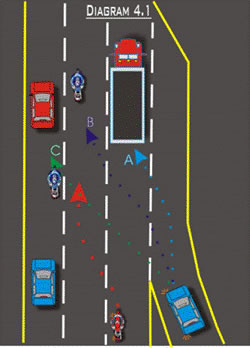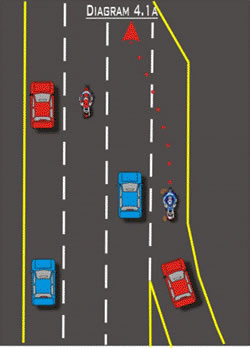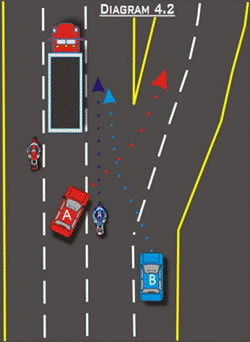Motorcycle on & off ramps
There are many who might argue that riding / driving on a highway is safer than riding on city streets. Even though speeds are higher everyone is usually traveling at similar speeds and in the same direction. I say “usually” because there will always be a percentage of drivers traveling at speeds well above or below the average speed of everyone else, as well as attempting bizarre maneuvers while on the road. These “bizarre maneuvers” usually occur in one place. That, boys and girls, is near On and Off ramps. The problem with on and off ramps is that a lot of people do not use them correctly.

Diagram 4.1:
In this diagram there is a rider approaching an on ramp as a car is entering onto the highway. The typical thing for the rider to do is to move over to the centre or left lane to give the car space to enter the roadway. Changing lanes doe not necessarily take the rider out of harms way however. As the car enters the highway he/ she will notice that there is a truck in the collector lane (A). Most drivers do not enjoy driving behind trucks, because they are usually traveling slower than the speed of other traffic. So that means that the driver will be looking to change lanes as quickly as possible, so that he/she can go on their merry way. This means that the driver of the car will more than likely end up in either lanes B or C (If he/she is like most drivers I see on the highway then they will make a bee-line for the passing lane C ). A rider should expect as well as have a plan incase this does happen.

Diagram 4.1a:
As a rider/ driver enters a highway there are a few things that he/ she should do to make their entrance as safe as possible. First off the driver should accelerate up to speed before trying to merge with vehicles already traveling on the highway/ freeway (it always amazes me when I see people attempting to enter a highway when their speed is far less than that of the traffic on the highway). The proper way to enter on to a highway is to signal your intent (as soon as drivers on the highway can see you), accelerate up to traffic speed (in the acceleration lane) and then merge when it is safe to do so. Merging correctly not only is safer for all drivers, but also causes fewer disruptions in the flow of traffic.

Diagram 4.2:
This diagram depicts an all too familiar site on the highway, the “last minute dash for the exit”. The driver of car (A) realizes that he/ she is about to miss his/ her exit. Instead of going to the next exit, this driver will careen across 2 or more lanes risking their life, as well as the life of anyone who might be in their way just to make their exit.
Another somewhat common situation is the driver of car (B) realizing that he/ she is in a lane that exits the highway attempts to get back on to the highway before it’s too late. It is crucial that a rider is aware of what is going on around him/ her, so that he/ she will not get caught between a driver and an off ramp. An alert rider can regularly predict what most drivers are about to do and take the proper steps to keep themselves out of harms way.
Ride Smart, Ride On!




